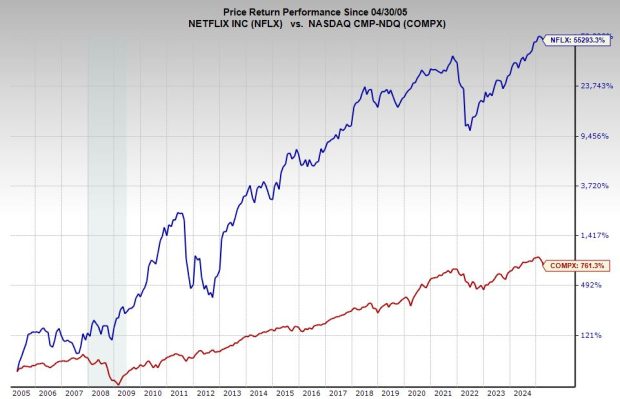Understanding Market Instability: Lessons from Amazon’s Success
When the Stock market experiences a significant decline, investors often feel uncertain about their next steps.
Editor’s Note: On Wednesday afternoon, President Trump implemented a 10% minimum tariff on all U.S. trading partners; in some cases, tariffs reached as high as 46%. This news was poorly received on Wall Street, resulting in a 4.8% drop in the S&P 500, a 4% decline in the Dow, and a 6% plunge in the NASDAQ during Thursday’s trading.
This morning, markets reacted further as China announced retaliatory tariffs of 34% on all U.S. goods, pushing stocks lower.
Amid this turmoil, it is crucial to remember how quickly markets can react. As chaos unfolds, I want to share Part 1 of an essay from InvestorPlace CEO Brian Hunt, offering valuable advice on what actions to take and, more importantly, what to avoid during market sell-offs. Look out for Part 2 tomorrow; I will reconnect with you next week.
************
Hello, Reader.
Experiencing a drop in the Stock market can significantly diminish your portfolio’s value, leading to uncertainty about how to respond.
In emotional times like these, it’s easy to make poor decisions due to stress.
- What about my retirement…?
- My kid’s college education…?
- My dreams of financial independence…?
When markets dive, it’s essential to identify actions you should take and equally important to recognize what you should avoid.
One useful perspective comes from analyzing one of the most significant business stories of the last century: Amazon.
Amazon is often recognized as one of the standout Stock market winners throughout history.
The company transitioned from a modest online bookseller to a leading global powerhouse, reaching a market value of $1 trillion in 2020.
Today, Amazon’s offerings extend to virtually everything, and its founder, Jeff Bezos, ranks among the wealthiest individuals worldwide.
Since its IPO in 1997, Amazon’s stock has soared over 120,000%, transforming every $10,000 investment into approximately $12 million.
Many can easily identify the factors contributing to Amazon’s success: its popular Prime membership service, efficient logistics reducing costs, and a lucrative cloud computing sector.
However, what you may not know is how the Dow Jones Industrial Average performed on March 4, 2015, or October 18, 2013, or any particular day of Amazon’s remarkable growth.
Chances are, you also do not recall the mortgage rates from December 12, 2003, or where the Federal Reserve had short-term interest rates on July 27, 2011.
These details about daily market movements are insignificant compared to Amazon’s operational success.
Recessions, bear markets, and Stock market corrections frequently become news headlines, yet they acted merely as minor hurdles along Amazon’s path to success.
What truly mattered for Amazon’s shareholders included the company’s continual innovation, commitment to customer value, and effective management strategies.
This principle holds true for countless successful companies: Apple, Disney, Starbucks, Google, Tesla, Visa, Home Depot, Nike, Chipotle, Netflix, Hershey, Microsoft, McDonald’s, Costco, and many more.
Market fluctuations, interest rates, and the political landscape did not significantly impact these companies’ journeys. Even severe downturns or presidential shifts proved inconsequential.
What makes the difference is a focus on innovation, favorable industry trends, delivering customer value, and effective business strategies.
Here is why these insights are crucial for you as an investor.
If you are investing in stocks for the long haul, you will inevitably encounter bear markets, recessions, and corrections.
During these downturns, even modest declines of around 15% can create fear.
Such fluctuations may lead you to question the viability of stock ownership.
In a long-term investment approach, you may find yourself inundated with “bearish” news and ominous forecasts.
A sector of journalists and analysts thrives on predicting calamity, whether it be runaway inflation or an impending economic collapse.
Such pessimistic outlooks can dominate the investment landscape. Despite positive advancements, these narratives can linger.
Our instincts are naturally drawn to potential threats, a trait that served our ancestors well against predators.
While bears and tigers may not be our primary fears today, our instincts still encourage us to focus on perceived risks, both real and imagined. Hence, we gravitate toward bearish headlines, impending disaster predictions, and media featuring gloomy forecasts.
As media insiders often say, “Fear sells” and “If it bleeds, it leads.”
I urge you to filter your decisions through common sense and factual information, rather than instinctual fears.
This conscious effort will lead to more successful investing.
You may wonder why I insist on this approach and what facts support it.
Consider that the Stock market has averaged an impressive annual return of 10% over the past century. This consistent performance is due to the strong impact of free markets and enterprise on human prosperity.
Here’s another critical statistic: during the 20th century, stocks grew in value by 1,500,000%.
This monumental gain means every $100 invested would become $1.5 million.
You may ask: didn’t the 20th century experience wars and economic downturns?
Absolutely.
Numerous global conflicts took place, resulting in widespread devastation and loss of life. Yet, through all challenges, the resilience of investment in stocks has remained fundamentally strong.
# U.S. Stock Market Resilience: Weathering Decades of Turmoil
Throughout history, various challenges have shaped the landscape of global finance. Notable events include the Great Depression, the Korean War, the Cuban Missile Crisis, the Watergate scandal, the inflation of the 1970s, the Arab oil embargo, the Vietnam War, and the savings and loan crisis of the 1990s.
In addition to these tumultuous events, the United States has faced over a dozen recessions and five significant bear markets.
Yet, amidst these difficulties, U.S. stocks rose dramatically. In fact, they appreciated by 1,500,000% during the 20th century.
Despite challenges occurring every decade, remarkable wealth has been generated by pioneering companies. Brands like Coca-Cola, Ford Motor, Apple, Hershey, Intel, Disney, General Electric, McDonald’s, Proctor & Gamble, Wrigley, Tootsie Roll, Pfizer, Microsoft, Walmart, and Starbucks played critical roles in this growth.
Challenges such as debt, poverty, and inequality exist in America. While these issues often dominate headlines and have inspired best-selling books, they can leave many feeling anxious.
However, understanding our history and the strength of American innovation provides no reason to abandon stocks or retreat from investing.
This exploration continues tomorrow…


Brian Hunt
CEO, InvestorPlace



